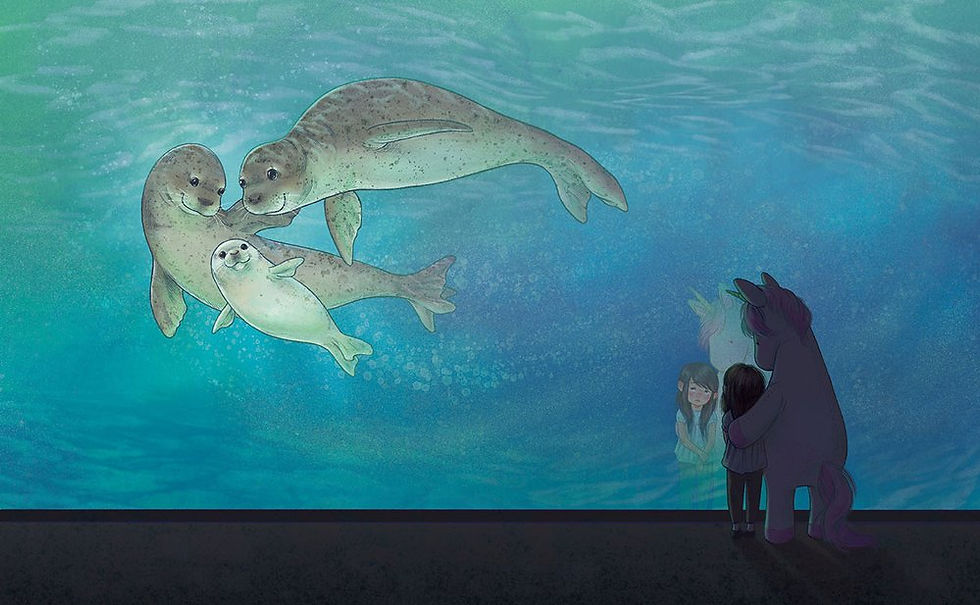For the month of May, I am excited to feature Ann Bonwill on the blog. I have used Ann's picture book THURSDAY in several sessions with children experiencing divorce or changes in their home situation and it strikes a chord with children on many levels.

Ann Bonwill enjoys writing children’s books every day of the week, but especially on Thursdays. She has lived and worked in many places, spending time as a social worker in Washington, DC, a teacher in Oxford, England, and a cinnamon bun baker in Albuquerque, New Mexico. Ann is the author of multiple picture books and nonfiction books for children, including I Don’t Want to be a Pea!, illustrated by Simon Rickerty, and The Frazzle Family Finds a Way, illustrated by Stephen Gammell. She lives in Virginia with her husband, son, and rescue Shar-Pei.

THURSDAY tells the story of a young girl who learns about her parents divorce on a Thursday. Told through the point of view of her stuffed unicorn friend who steps in to help, the book shows their adventures through both cheerful moments and times when feelings are difficult.
Ann, thank you for joining us this month! I'm a big fan of your writing.
To start, can you tell us what the inspiration was for THURSDAY?
Thursday was inspired by an illustration shared with me by my agent, Marietta Zavker. The illustration is not in the book, but it showed a small character that I thought could be a toy come to life. The character inspired me to write a story from the point of view of a toy that supports its child through a difficult time. Because of this focus, Thursday is as much about being a good friend as it is about experiencing a divorce.
THURSDAY approaches the topic of divorce in such a gentle way for readers. What influenced your decision not to directly address divorce in the text?
Thursday started as a book about loss. As I wrote it, I drew on my own experiences of loss in various forms. I wanted to make the story as universal as possible, so I didn't specify why the main character was missing her parent. In my mind it could have been due to divorce, death, or even deployment. Later in the process my agent and I decided to focus on divorce and the illustrations were created with that theme in mind. At that point, I changed the text just a bit to fit the separation storyline, but I mostly kept it general. I hope that by not being too specific, more kids would be able to see themselves in the situation. I feel that the story is still ultimately about loss and change, as well as support and kindness, and in that way most everyone can relate. What was the process like from inspiration to publication?
The process was truly a collaboration between me, my agent, the talented illustrator Kayla Harren, and the editorial staff at Two Lions. It took many years to go from the spark of inspiration to the final product. With most traditionally published picture books, the illustrator is chosen by the publisher. In the case of Thursday, Kayla and I were matched by our agent, Marietta. The story then found a home at Two Lions. The book was made better by every hand that touched it each step of the way. Do you have a scene in the book that was your favorite to write or see illustrated?
I was blown away when I saw Kayla's illustration of the scene at the aquarium when the day turns from good to bad. I had imagined the main character seeing a family together, which would remind her that her own family was splitting apart. I love how Kayla made this family a family of seals. Her use of space and color on the page is striking. It perfectly captures the bittersweet moment and conveys the main character's pain and loneliness. It is a turning point in the story.

How can parents, teachers, or counselors use your books to engage in deeper conversations with kids?
I think my books work well when read one-on-one with a child in a quiet moment. Adults can ask open-ended questions and follow the child's lead in the discussion. One idea is to ask what the characters are feeling at various points in the story. This type of question can help a child learn to express feelings in words and develop a sense of empathy. Do you have any advice for authors who want to write about tough topics?
My advice is not to shy away from topics that are meaningful to you. Kids can handle tough things. They live through difficult times in real life, and seeing these topics depicted in books can help them make sense of their own situations and understand the experiences of others. I think it is important to respect the child reader and not lecture them or talk down to them. Let the lessons arise naturally from the story without being too heavy-handed or message-y. Where can we find you to keep up with your work?
The best place to find me is my website: www.annbonwill.com. I love to hear from readers and writers!
Ann, thank you so much for taking the time to answer my questions! Readers, grab your copy of Thursday here.







